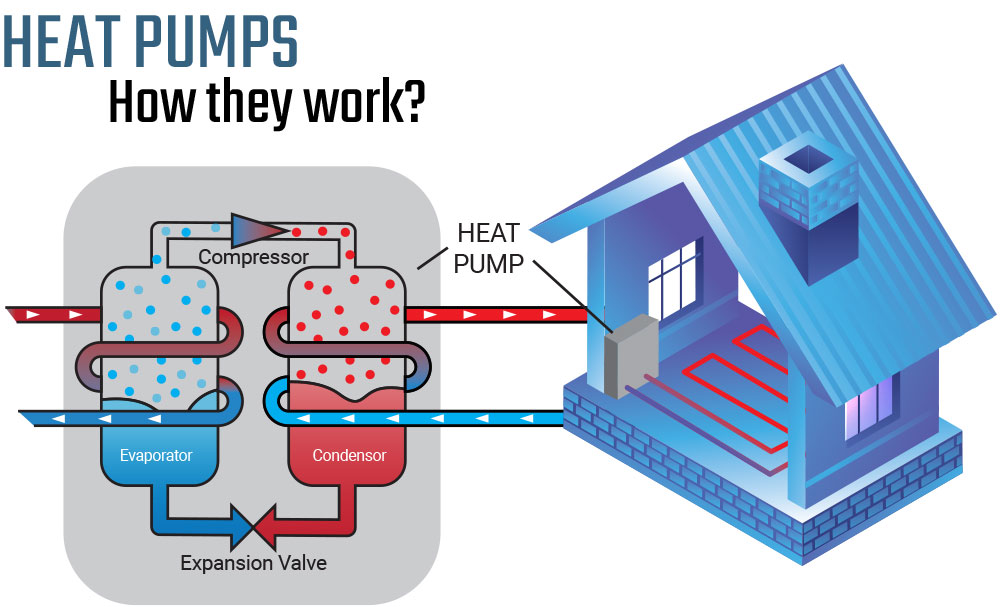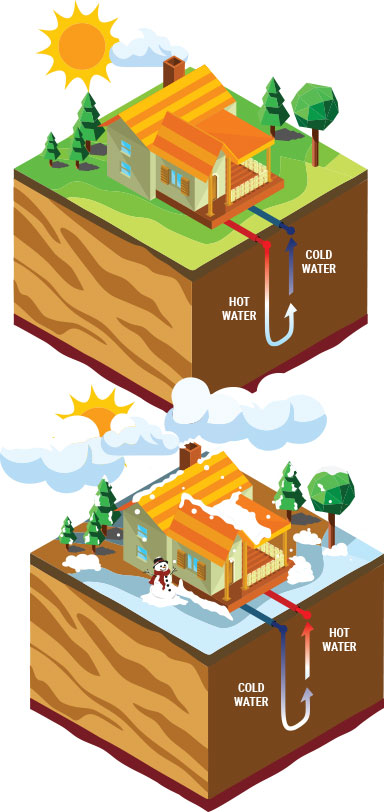Geothermal heat pumps (GHPs)
Geothermal heat pumps:
energy from the ground
energy from the ground
Heating and cooling with geothermal heat pump are efficient and environmentally friendly.
How do heat pumps work?
A heat pump is an electrically driven device that extracts heat from a low temperature place (a source), and delivers it to a higher temperature place (a sink).
Heat naturally flows from places with higher temperature to locations with lower temperatures (e.g., in the winter, heat from inside the building is lost to the outside). A heat pump uses additional electrical energy to counter the natural flow of heat, and pump the energy available in a colder place to a warmer one.

So how does a heat pump heat or cool your home? As energy is extracted from a source, the temperature of the source is reduced. If the home is used as the source, thermal energy will be removed, cooling this space. This is how a heat pump operates in cooling mode, and is the same principle used by air conditioners and refrigerators. Similarly, as energy is added to a sink, its temperature increases. If the home is used as a sink, thermal energy will be added, heating the space. A heat pump is fully reversible, meaning that it can both heat and cool your home, providing year-round comfort.
Relative to air-source heat pumps, they are quieter, last longer, need little maintenance, and do not depend on the temperature of the outside air.

Types of heat pumps
Ground source heat pumps
Ground source heat pumps (GSHPs) use a series of ground loops to absorb heat energy from the ground. These loops can either be installed in horizontal trenches around one meter in depth, or vertically in a borehole. Boreholes offer a little less disruption to the surrounding landscape but may require a little more capital upfront for the installation.
GSHPs can be better suited for new build developments where the need for external space, (to install the ground loop) and the internal space (for the buffer tank and water cylinder) can be factored in at the early design stages. They can also be installed in existing buildings where the space and geographical needs are met and disruption is not an issue.
Due to the nature of ground source heat pump installations, groundworks and existing infrastructure need early consideration for this type of heat pump, which can be more costly to install depending on the building location.
Ground source heat pumps are used across commercial and residential developments and often offer the best all year-round efficiencies due to the potentially higher and consistent temperature of the ground they draw energy from.
Water source heat pumps
The heat energy can be taken from underground waters that are on temperature of 15 °C throughout the whole year. From a drilled well the water is brought into the heat exchanger in which one part of the underground water is transmitted into the ecological Freon which evaporates.
Partially cooled water returns to the second well which is the same deepness as the first well so in that way the flows of the underground water are not disturbed. The Freon which is now into gas condition is pressed via compressor and releases latent transferred heat to the water that circulates through the condensers and heat systems in buildings.
Air source heat pumps
The heat pump draws heat from the outside air during the heating season and rejects heat outside during the summer cooling season.
It may be surprising to know that even when outdoor temperatures are cold, a good deal of energy is still available that can be extracted and delivered to the building. For example, the heat content of air at -18°C equates to 85% of the heat contained at 21°C. This allows the heat pump to provide a good deal of heating, even during colder weather.
 QUINCE M PRO
QUINCE M PRO